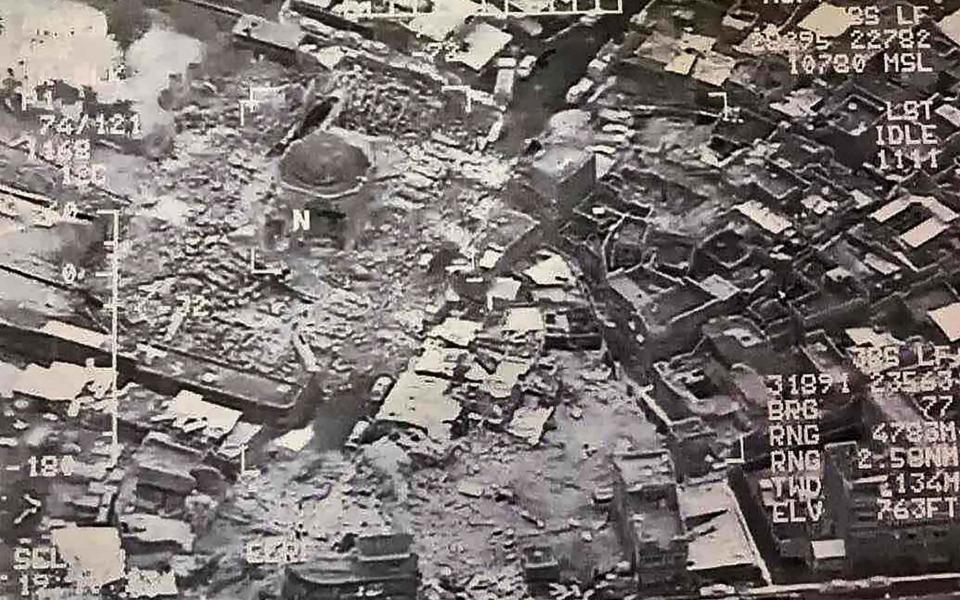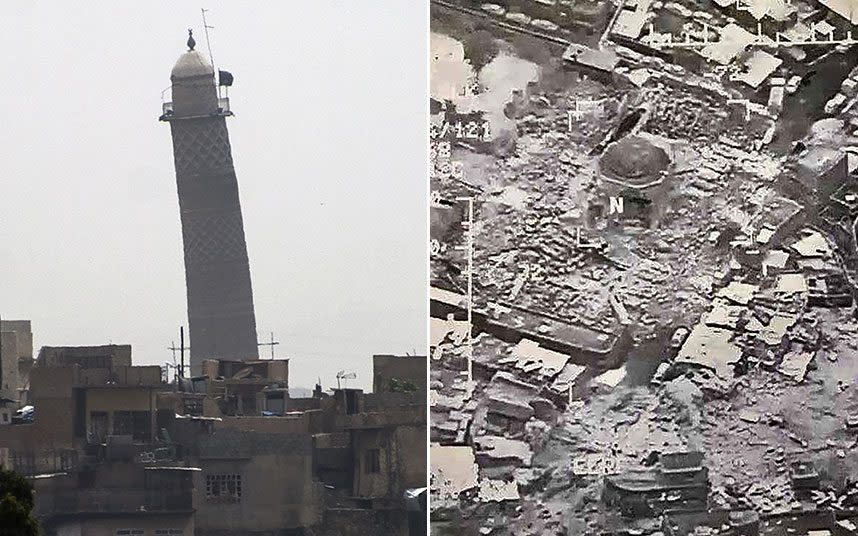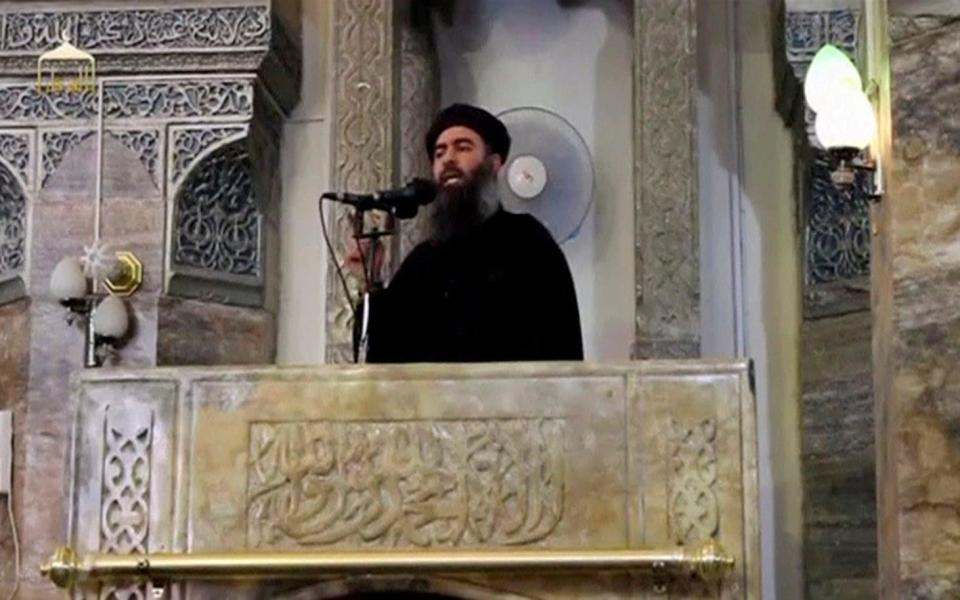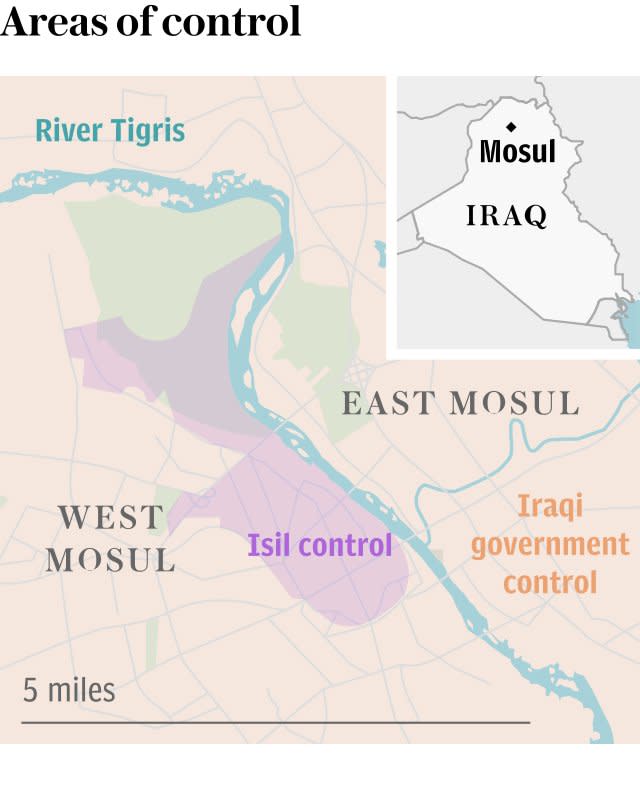Islamic State blows up landmark Great Mosque of al-Nuri and famous leaning minaret in Mosul

The destruction of the Mosul mosque where Isil’s leader declared his caliphate marks the group’s defeat, Prime Minister Haider al-Abadi said, as Unesco mourned the loss of one of Iraq’s most venerated sites.
The 12th century Grand Mosque of al-Nouri was captured three years ago by the jihadists, who blew it up with explosives on Wednesday night after Iraqi forces advanced to within 150 feet.
The mosque's famous leaning minaret, which earned the nickname of Iraq’s Tower of Pisa, had dominated skyline of Iraq’s second city for centuries and is pictured on the country’s 10,000 dinar banknote.

“Daesh’s bombing of the al-Hadba minaret and the al-Nouri Mosque is a formal declaration of their defeat,” Mr Abadi said.
The militants had claimed a US-led coalition air strike had brought down the mosque, but the Iraqi army released aerial footage which appeared to show the moment Islamic State of Iraq and the Levant (Isil) detonated explosives laid along the shaft.
The destruction of the minaret, which took place on the holiest day of the Islamic calendar, Laylat al-Qadr - the moment the Koran was revealed to the prophet Mohammed, has shocked Muslims worldwide.
However, it had been widely anticipated, with commanders saying Isil would not have allowed Iraqi forces to score a hugely symbolic victory by recapturing the site.

Abu Bakr al-Baghdadi, Isil’s leader, made his first and only public appearance at the pulpit of the mosque when he declared his so-called “caliphate”on June 29, 2014.
"They blew up this place in an attempt to cover up their heavy losses in the media, but the media and the people see the victories and see the collapse of Daesh," said Brigadier General Falah Fadel al-Obeidi, from the elite Counter-Terrorism Service.
The destruction by jihadists of the leaning minaret, affectionately known as the Hadba, or Hunchback, "deepens the wounds" in war-torn Iraq, Irina Bokova, chief of the UN’s cultural agency said Thursday.
"This new destruction deepens the wounds of a society already affected by an unprecedented humanitarian tragedy."
Isil has waged a campaign described by the UN as "cultural cleansing", razing ancient relics and looting artefacts to sell on the black market.

For residents of Mosul the destruction was yet another painful loss, after so many years of the Isil violently erasing a region’s history.
"In the early morning, I climbed up to my house roof and was stunned to see the Hadba minaret had gone," Nashwan, a labourer living in Khazraj neighborhood near the mosque, said by phone. "I broke into tears. I felt I had lost a son of mine."
Mosul blogger MosulEye, who writes anonymously about life in the city, said: “Will the sun ever shine again over Mosul without Hadbaa? Never.
“My mother, the land I was brought up on, and picked me up every time I felt is gone My city that I am fighting to liberate just got assassinated.”

On Wednesday morning, US and British-backed Iraqi forces began a push towards the mosque, having encircled jihadi fighters in the Old City.
An estimated 100,000 civilians are holed up in the Old City with the last remaining Isil troops in Mosul, the UN has stated, warning they could be used as human shields.
As Iraq's Counter Terrorism Service (CTS) troops closed in on the mosque, Isil blew it up.
Iraqi officials had privately expressed the hope that the mosque could be captured in time for Eid al-Fitr, the festival marking the end of Ramadan, the Muslim fasting month, Reuters reports. The first day of Eid falls this year on June 25 or 26 in Iraq.

Baghdadi is believed to be hiding in the border area between Iraq and Syria. Russia claimed last week he had been killed in an air strike, but there has been no confirmation.
Major General Rupert Jones, the British deputy commander of the international coalition fighting Isil, said: "If you were a Daesh fighter (..) I don't sense you would feel as though you are being led by Baghdadi."
The mosque was built by the Turkic ruler of Mosul, Nur al-Din Mahmoud Zangi, who helped unify Arab forces against the European Crusaders.
He ordered its construction in 1172, two years before his death. The mosque and minaret are pictured on Iraq's 10,000 dinar bank note.
Originally standing at 150 feet, the minaret was leaning noticeably by the 14th century and given the nickname "al-Hadba" (the humpback). It was also sometimes referred to as Iraq's Tower of Pisa.

"The minaret of Al-Hadba has been here forever, it is part of the history of Mosul, it is the symbol of the city," Ahmed Thilij Hamed, a 49-year-old resident of a neighbourhood near the Old City, told AFP on Monday.
Isil attempted to destroy the minaret in July 2014, saying the structure contradicted their fundamentalist interpretation of Islam. However, Mosul residents protected it by forming a human chain.
It is the latest historically significant site in the region to be destroyed by Isil.
In May 2015, jihadists overran the oasis city of Palmyra in Syria and destroyed countless priceless artifacts.
In January, the militants blew up the famous Tetrapylon monument and damaged a Roman theatre in Palmyra.


 Yahoo News
Yahoo News 